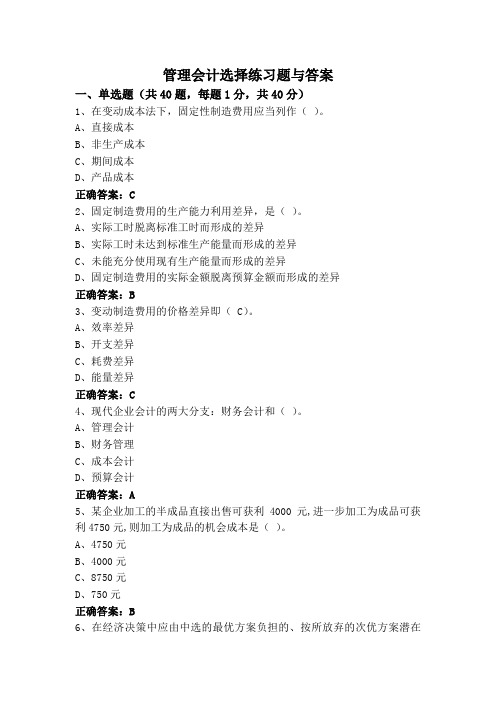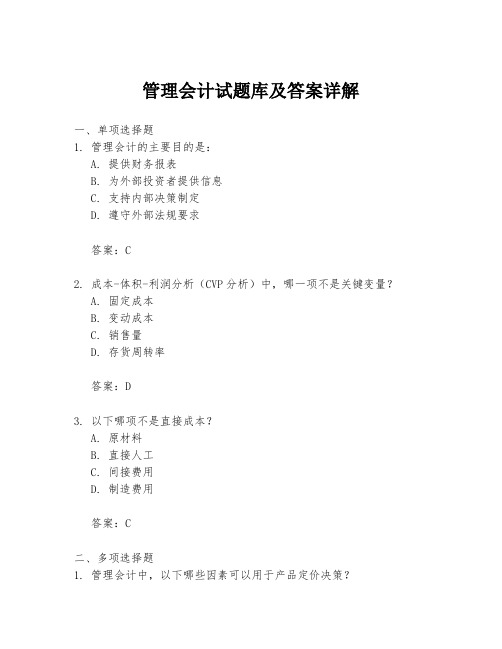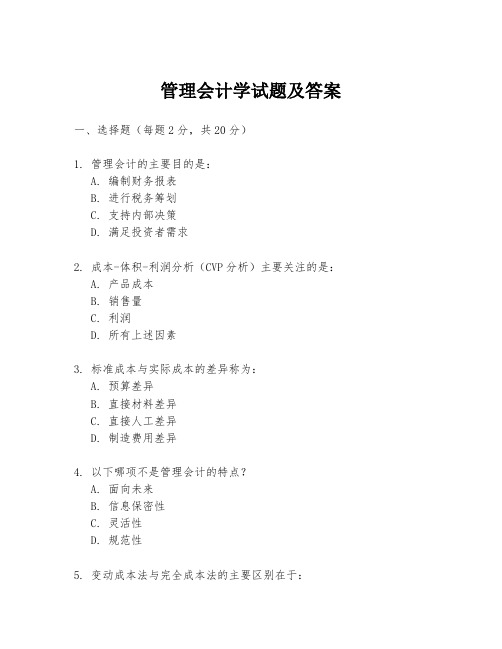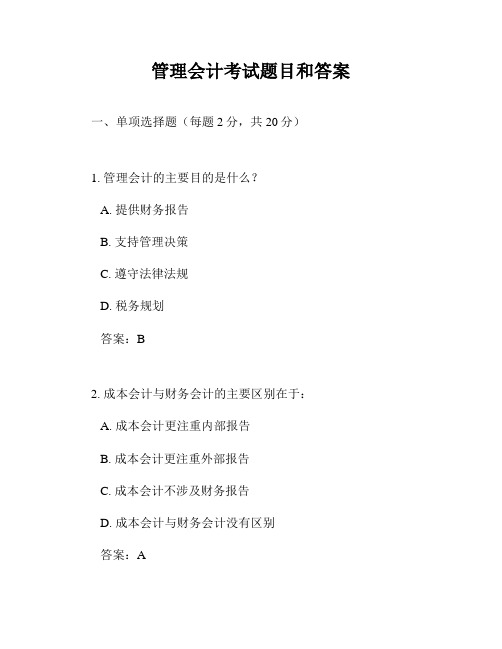(精选)管理会计选择题
管理会计选择练习题与答案

管理会计选择练习题与答案一、单选题(共40题,每题1分,共40分)1、在变动成本法下,固定性制造费用应当列作()。
A、直接成本B、非生产成本C、期间成本D、产品成本正确答案:C2、固定制造费用的生产能力利用差异,是()。
A、实际工时脱离标准工时而形成的差异B、实际工时未达到标准生产能量而形成的差异C、未能充分使用现有生产能量而形成的差异D、固定制造费用的实际金额脱离预算金额而形成的差异正确答案:B3、变动制造费用的价格差异即( C)。
A、效率差异B、开支差异C、耗费差异D、能量差异正确答案:C4、现代企业会计的两大分支:财务会计和()。
A、管理会计B、财务管理C、成本会计D、预算会计正确答案:A5、某企业加工的半成品直接出售可获利4000元,进一步加工为成品可获利4750元,则加工为成品的机会成本是()。
A、4750元B、4000元C、8750元D、750元正确答案:B6、在经济决策中应由中选的最优方案负担的、按所放弃的次优方案潜在受益计算的那部分资源损失,就是所谓()。
A、沉没成本B、机会成本C、专属成本D、增量成本正确答案:B7、设某企业有固定搬运工10名,工资总额5000元;当产量超过3000件时,就需雇佣临时工。
临时工采用计件工资制,单位工资为每件1元,则该企业搬运工工资属于()。
A、阶梯式成本B、曲线成本C、延期变动成本D、半变动成本正确答案:C8、下列各项中,与传统的财务会计相对立概念而存在的是()。
A、现代会计B、成本会计学C、企业会计D、管理会计正确答案:D9、在关于变动成本法的应用上,下列说法中唯一正确的是()A、变动成本法可以与制造成本法同时使用,以提供两套平行的核算资料B、变动成本法的积极作用决定了它可以取代制造成本法C、变动成本法和制造成本法根本无法结合D、变动成本法和制造成本法的有机结合是最理想的做法。
正确答案:D10、已知企业某产品的单价为2 000元,目标销售量为3 500件,固定成本总额为100 000元,目标利润为600 000元,则企业应将单位变动成本的水平控制在( )。
管理会计学考试题及答案

管理会计学考试题及答案一、单项选择题(每题2分,共20分)1. 管理会计的目的是()A. 提供对外报告的财务信息B. 为企业内部管理决策提供信息C. 制定企业的长期战略规划D. 监督企业的财务状况2. 成本会计与财务会计的主要区别在于()A. 成本会计只关注生产成本B. 财务会计只关注历史信息C. 成本会计侧重于内部决策,财务会计侧重于对外报告D. 成本会计不涉及财务报告3. 下列哪项不是管理会计的职能?()A. 规划与预算B. 成本控制C. 绩效评价D. 税务筹划4. 标准成本法中,实际成本与标准成本之间的差异称为()A. 成本差异B. 标准差异C. 预算差异D. 绩效差异5. 变动成本法与完全成本法的主要区别在于()A. 存货成本的计算方法B. 固定成本的分配方法C. 销售收入的确认方法D. 利润的计算方法6. 管理会计中,用于评估投资项目经济效益的方法是()A. 净现值法B. 标准成本法C. 变动成本法D. 责任会计法7. 在管理会计中,预算的作用不包括()A. 规划未来活动B. 控制成本费用C. 评价员工绩效D. 确定产品售价8. 下列哪项不是管理会计中的成本概念?()A. 直接成本B. 间接成本C. 变动成本D. 机会成本9. 管理会计中,用于分析产品盈利能力的方法是()A. 成本-体积-利润分析B. 标准成本分析C. 预算分析D. 责任中心分析10. 管理会计中,用于控制成本的方法是()A. 标准成本法B. 变动成本法C. 责任会计法D. 净现值法二、多项选择题(每题3分,共15分)1. 管理会计信息的特点包括()A. 面向未来B. 灵活性强C. 针对性强D. 客观性高2. 管理会计中的成本分析方法包括()A. 成本-体积-利润分析B. 标准成本法C. 变动成本法D. 责任会计法3. 管理会计在企业中的应用包括()A. 成本控制B. 预算管理C. 绩效评价D. 投资决策4. 管理会计中的成本概念包括()A. 直接成本B. 间接成本C. 变动成本D. 固定成本5. 管理会计中用于评估投资项目的方法包括()A. 净现值法B. 内部收益率法C. 回收期法D. 投资回报率法三、简答题(每题5分,共20分)1. 简述管理会计与财务会计的主要区别。
《管理会计》试题库及答案

《管理会计》专科题库及答案一.单项选择题1.C 2.C 3.C 4.C 5.B 6.B 7.C 8.D 9.C 10.A 11.B 12.C 13.B 14.B 15.D 16.B 17.D 18.A 19.B 20.C 21.C 22.A 23.C 24.C 25.C 26.B 27.B 28.C 29.C 30.D 31.A 32.D 33.B 34.C 35.A 36.A 37.B 38.C 39.B 40.D 41.C 42.A 43.A 44.B 45.D 46.C 47.D 48.A 49.C 50.B 51.D 52.B 53.B 54.C 55.A 56.B 57.D 58.A 59.C 60.A 61.D 62.C 63.D 64.C 65.B 66.D 67.A 68.B 69.C 70.D 71.B 72.C 73.B 74.D 75.B 76.C 77.D 78.B 79.B 80.D 81.A 82.D 83.D 84.A 85.C 86.B 87.B 88.A 89.C 90.B 91.B 92.C 93.D 94.D 95.B 96.A 97.C 98.B 99.B 100.A 101.C 102.B 103.C 104.C 105.C 106.B 107.A 108.B 109.C 110.A 111.D 112.B 113.A 114.B 115.B 116.A117.A118.A119.D 120.A1.下列各项中,与传统的财务会计相对立概念而存在的是()。
A.现代会计B.企业会计C.管理会计D.管理会计学2.现代管理会计的一个重要特征是()。
A.具有统一性和规范性B.必须遵循公认的会计原则C.方式方法更为灵活多样D.方法单一3.在Y=a+()X中,Y表示总成本,a表示固定成本,X表示销售额,则X的系数应是()。
A.单位变动成本B.单位边际贡献C.变动成本率D.边际贡献率4.单位产品售价减去单位变动成本的差额称为()。
管理会计参考试题及答案

管理会计参考试题及答案一、单项选择题1. 管理会计的主要目的是:A. 编制财务报表B. 为外部投资者提供信息C. 为内部管理层提供决策支持D. 遵守会计准则答案:C2. 成本-体积-利润(CVP)分析中,利润的计算公式是:A. 利润 = 销售收入 - 变动成本B. 利润 = 销售收入 - 总成本C. 利润 = 固定成本 / 贡献边际率D. 利润 = 贡献边际 - 固定成本答案:D3. 标准成本与实际成本的差异称为:A. 直接成本差异B. 间接成本差异C. 成本差异D. 预算差异答案:C4. 以下哪项不是管理会计的基本原则?A. 相关性原则B. 可靠性原则C. 历史成本原则D. 可比性原则答案:C5. 预算编制过程中,固定预算与弹性预算的主要区别在于:A. 固定预算基于不变的成本结构B. 弹性预算基于不同的业务量C. 固定预算适用于长期规划D. 弹性预算适用于短期控制答案:B二、多项选择题6. 以下哪些属于管理会计的职能?A. 成本控制B. 财务报告C. 预算编制D. 投资决策分析答案:A, C, D7. 标准成本的制定需要考虑以下哪些因素?A. 原材料价格B. 直接人工成本C. 直接材料消耗量D. 间接费用答案:A, B, C8. 以下哪些方法可以用于成本控制?A. 预算控制B. 标准成本控制C. 责任会计控制D. 经济订货量控制答案:A, B, C三、判断题9. 管理会计只关注历史数据,不涉及未来预测。
(对/错)答案:错10. 管理会计与财务会计可以完全替代对方。
(对/错)答案:错四、简答题11. 简述管理会计与财务会计的主要区别。
答案:管理会计与财务会计的主要区别在于目的、使用者、信息类型、报告频率、法规约束等方面。
管理会计主要为内部管理层提供决策支持,信息类型更注重相关性,报告频率灵活,不受法规严格约束;而财务会计主要为外部投资者、债权人等提供信息,信息类型注重可靠性和一致性,报告频率固定,并且需要遵守会计准则和法规。
管理会计试题库及答案详解

管理会计试题库及答案详解一、单项选择题1. 管理会计的主要目的是:A. 提供财务报表B. 为外部投资者提供信息C. 支持内部决策制定D. 遵守外部法规要求答案:C2. 成本-体积-利润分析(CVP分析)中,哪一项不是关键变量?A. 固定成本B. 变动成本C. 销售量D. 存货周转率答案:D3. 以下哪项不是直接成本?A. 原材料B. 直接人工C. 间接费用D. 制造费用答案:C二、多项选择题1. 管理会计中,以下哪些因素可以用于产品定价决策?A. 市场需求B. 成本结构C. 竞争对手定价D. 政府规定答案:A, B, C2. 标准成本与实际成本的比较可以用于:A. 成本控制B. 预算编制C. 绩效评估D. 投资决策答案:A, C三、判断题1. 管理会计只关注短期决策。
()答案:错误2. 管理会计信息只对内部人员开放。
()答案:正确四、简答题1. 简述管理会计与财务会计的区别。
答案:管理会计主要服务于组织内部的决策制定,侧重于提供定制化、灵活的信息,通常不对外公开。
财务会计则侧重于对外报告,遵循特定的会计准则和法规,提供标准化的财务报表。
2. 解释什么是全面预算,并说明其在企业管理中的作用。
答案:全面预算是企业对未来一定时期内财务状况和经营成果的预计,包括销售预算、生产预算、成本预算等。
它有助于企业协调各部门活动,控制成本,评估绩效,并为战略规划提供依据。
五、计算题1. 某公司生产一种产品,其固定成本为$100,000,单位变动成本为$20,销售价格为$50。
若公司希望实现利润$30,000,请计算该公司需要销售多少单位产品。
答案:首先计算单位利润,即销售价格减去单位变动成本:$50 - $20 = $30。
然后,用目标利润除以单位利润,再加上固定成本除以单位利润,得到所需销售量:$30,000 / $30 + $100,000 / $30 =1,000 + 3,333.33 = 4,333.33。
管理会计学试题及答案

管理会计学试题及答案一、选择题(每题2分,共20分)1. 管理会计的主要目的是:A. 编制财务报表B. 进行税务筹划C. 支持内部决策D. 满足投资者需求2. 成本-体积-利润分析(CVP分析)主要关注的是:A. 产品成本B. 销售量C. 利润D. 所有上述因素3. 标准成本与实际成本的差异称为:A. 预算差异B. 直接材料差异C. 直接人工差异D. 制造费用差异4. 以下哪项不是管理会计的特点?A. 面向未来B. 信息保密性C. 灵活性D. 规范性5. 变动成本法与完全成本法的主要区别在于:A. 计算利润的方法B. 计算成本的方法C. 计算收入的方法D. 计算税金的方法二、简答题(每题10分,共30分)1. 简述管理会计与财务会计的区别。
2. 解释什么是直接成本和间接成本,并举例说明。
3. 描述预算编制的基本步骤。
三、计算题(每题25分,共50分)1. 某公司生产一种产品,其标准成本如下:- 直接材料:每单位10元- 直接人工:每单位5元- 变动制造费用:每单位3元- 固定制造费用(每月):10000元假设公司本月生产了1000单位产品,实际成本如下:- 直接材料:每单位11元,实际使用了1100单位- 直接人工:每单位6元,实际使用了1100单位- 变动制造费用:每单位4元- 固定制造费用(实际):11000元计算直接材料差异、直接人工差异和变动制造费用差异。
2. 某公司预计下月销售量为5000单位,每单位售价为20元,每单位变动成本为12元。
公司固定成本总额为50000元。
计算公司的盈亏平衡点销售量。
答案一、选择题1. C2. D3. B4. D5. B二、简答题1. 管理会计与财务会计的区别主要体现在:- 目的:管理会计主要支持企业内部决策,财务会计则主要对外报告财务状况。
- 信息使用者:管理会计信息主要供企业内部管理者使用,财务会计信息则供外部利益相关者使用。
- 信息特点:管理会计信息更加灵活,可以针对不同决策需求定制,财务会计信息则需要遵循严格的会计准则。
管理会计考试题目和答案

管理会计考试题目和答案一、单项选择题(每题2分,共20分)1. 管理会计的主要目的是什么?A. 提供财务报告B. 支持管理决策C. 遵守法律法规D. 税务规划答案:B2. 成本会计与财务会计的主要区别在于:A. 成本会计更注重内部报告B. 成本会计更注重外部报告C. 成本会计不涉及财务报告D. 成本会计与财务会计没有区别答案:A3. 在管理会计中,变动成本是指:A. 随产量变化而变化的成本B. 随时间变化而变化的成本C. 随员工数量变化而变化的成本D. 随销售量变化而变化的成本答案:A4. 标准成本法中,标准成本是指:A. 实际成本B. 预算成本C. 理想成本D. 历史成本答案:C5. 以下哪项不是管理会计的职能?A. 成本控制B. 预算编制C. 财务报告D. 绩效评价答案:C6. 管理会计中,作业成本法的主要优点是:A. 简化成本分配B. 提高成本分配的准确性C. 减少间接费用D. 降低成本答案:B7. 以下哪项是管理会计中的责任会计?A. 成本会计B. 财务会计C. 税务会计D. 管理会计答案:D8. 以下哪项不是管理会计中的决策支持工具?A. 敏感性分析B. 盈亏平衡分析C. 现金流量表D. 决策树答案:C9. 在管理会计中,以下哪项不是非财务指标?A. 市场份额B. 客户满意度C. 利润率D. 产品质量答案:C10. 以下哪项是管理会计中的短期决策?A. 资本预算B. 产品定价C. 存货管理D. 长期投资答案:C二、多项选择题(每题3分,共15分)1. 管理会计在企业中的作用包括:A. 支持战略规划B. 提高运营效率C. 促进财务合规D. 增强客户关系答案:A, B, C2. 以下哪些因素会影响产品的标准成本?A. 标准材料成本B. 标准人工成本C. 标准制造费用D. 产品销售价格答案:A, B, C3. 管理会计中的预算编制包括:A. 销售预算B. 生产预算C. 现金预算D. 人力资源预算答案:A, B, C, D4. 以下哪些是管理会计中的成本控制方法?A. 标准成本法B. 作业成本法C. 责任成本法D. 目标成本法答案:A, C, D5. 管理会计中的绩效评价指标可能包括:A. 投资回报率(ROI)B. 资产周转率C. 每股收益(EPS)D. 客户留存率答案:A, B, D三、判断题(每题2分,共10分)1. 管理会计只关注企业的内部活动。
管理会计考试题及答案

管理会计考试题及答案**管理会计考试题及答案**一、单项选择题(每题2分,共20分)1. 管理会计的主要目的是什么?A. 提供财务报告B. 内部决策支持C. 税务规划D. 投资者关系管理答案:B2. 成本会计与财务会计的主要区别在于:A. 成本会计只关注成本B. 成本会计只关注收入C. 成本会计关注内部管理决策D. 成本会计关注外部报告答案:C3. 变动成本法下,固定制造费用在利润表中如何体现?A. 作为销售成本的一部分B. 作为管理费用的一部分C. 作为营业外支出D. 不体现答案:B4. 以下哪项不是管理会计中的标准成本计算的组成部分?A. 直接材料标准成本B. 直接人工标准成本C. 制造费用标准成本D. 销售费用标准成本答案:D5. 管理会计中的预算编制通常不包括以下哪项?A. 销售预算B. 生产预算C. 现金预算D. 利润分配预算答案:D6. 以下哪项不是管理会计中的责任会计的要素?A. 责任中心B. 成本中心C. 利润中心D. 投资回报率答案:D7. 以下哪项不是管理会计中转移价格的确定方法?A. 市场价格B. 成本加成C. 协商价格D. 固定价格答案:D8. 以下哪项不是管理会计中平衡计分卡的四个维度?A. 财务维度B. 客户维度C. 内部流程维度D. 员工满意度维度答案:D9. 以下哪项不是管理会计中作业成本法(ABC)的优点?A. 提供更准确的产品成本信息B. 简化成本分配过程C. 有助于成本控制和降低成本D. 有助于产品定价和利润分析答案:B10. 以下哪项不是管理会计中经济增加值(EVA)的计算公式组成部分?A. 税后营业利润B. 资本成本C. 资产总额D. 股东权益答案:D二、多项选择题(每题3分,共30分)1. 管理会计信息的特点包括:A. 及时性B. 相关性C. 可靠性D. 灵活性答案:ABCD2. 以下哪些因素会影响标准成本的设定?A. 市场价格B. 历史成本C. 行业标准D. 预算目标答案:ABCD3. 管理会计中的成本分析方法包括:A. 成本-体积-利润分析B. 本量利分析C. 敏感性分析D. 趋势分析答案:ABC4. 以下哪些是管理会计中预算的类型?A. 静态预算B. 弹性预算C. 零基预算D. 滚动预算答案:ABCD5. 以下哪些是管理会计中的责任会计的中心类型?A. 成本中心B. 利润中心C. 投资中心D. 销售中心答案:ABC6. 以下哪些是管理会计中转移价格的确定方法?A. 市场价格B. 成本加成C. 协商价格D. 固定价格答案:ABC7. 以下哪些是管理会计中平衡计分卡的四个维度?A. 财务维度B. 客户维度C. 内部流程维度D. 员工满意度维度答案:ABC8. 以下哪些是管理会计中作业成本法(ABC)的优点?A. 提供更准确的产品成本信息B. 简化成本分配过程C. 有助于成本控制和降低成本D. 有助于产品定价和利润分析答案:ACD9. 以下哪些是管理会计中经济增加值(EVA)的计算公式组成部分?A. 税后营业利润B. 资本成本C. 资产总额D. 股东权益答案:AB10. 以下哪些是管理会计中决策分析的方法?A. 净现值(NPV)B. 内部收益率(IRR)C. 投资回收期(PBP)D. 盈亏平衡点分析答案:ABCD三、判断题(每题2分,共20分)1. 管理会计只提供历史成本信息,不涉及未来预测和决策支持。
- 1、下载文档前请自行甄别文档内容的完整性,平台不提供额外的编辑、内容补充、找答案等附加服务。
- 2、"仅部分预览"的文档,不可在线预览部分如存在完整性等问题,可反馈申请退款(可完整预览的文档不适用该条件!)。
- 3、如文档侵犯您的权益,请联系客服反馈,我们会尽快为您处理(人工客服工作时间:9:00-18:30)。
管理会计Chapter11. How is management accountable to the owners of the company?A. Providing goods and services at a reasonable priceB. Providing a safe work environmentC. Making loan paymentsD. Providing a return on investments2.Indicate whether the following are characteristics of financial accounting(F) or management accounting (M).Primary users are investors and stakeholders F The focus is on relevance of the information and looking towards the future M Concern exists on how information affects employees M Rules are prescribed by Generally Accepted Accounting Principles (GAAP) F Reports are usually summarized and prepared on a quarterly or annual basis F3. Which of the following is NOT a current business trendA. A shift to a product-based economyB. Global competitionC. Just-in-time managementD. Total quality management4. Identify the following as product or period costs for a merchandiser: Cost of inventory items productAdvertising periodSalaries periodFreight-in productDelivery expense period5. Which of the following is an inventory account of a manufacturing company?A. Direct materialsB. Work in processC. Finished goodsD. All of the above6. Which of the following is an indirect cost of a manufacturer?A. Direct materialB. Direct laborC. Manufacturing overheadD. All of the above8. Which inventory account is used to compute Cost of goods sold for a manufacturer?A. Direct materialsB. Work in processC. Finished goodsD. Merchandise inventory9. What is the difference between“total manufacturing costs incurred”and “cost of goods manufactured”?A. The change in Work in process inventory.B. Total manufacturing costs does not include manufacturing overhead.C. Cost of goods manufactured only includes direct costs.D. There is no difference.10. Which of the following is a required ethical standard of the Institute of Management Accountants?A. Maximization of profitB. ProductivityC. EfficiencyD. Integrity答案:1.D 3.A 5.D 6.C 8.C 8.A 10.DChapter31. Activity-based costing:A. determines a cost driver for each production activity.B. is less accurate than using a predetermined overhead application rate.C. is less common in a competitive business environment.D. is all of the above.2. Under ABC, which of the following would be a reasonable cost driver for materials handling?A. Direct labor hoursB. Machine hoursC. Number of partsD. Square feet of warehouse3. What types of decisions are made with activity-based management?A. PricingB. Product mixC. Cost cuttingD. All of the above4. This method of pricing begins with the amount customers are willing to pay and subtracts desired profit to determine the desired cost.A. Traditional costingB. Target pricingC. Market-based costingD. Price profit analysis5. Which of the following is NOT a characteristic of just-in-time (JIT) production?A. Small quantity of materials on handB. Machines and workers grouped in “cells”C. Strong relationship with suppliersD. Minimization of lost sales6. What is unique about accounting for product costs in a JIT system?A. Costs aren’t recorded until the goods are complete.B. Manufacturing overhead is not allocated to goods.C. Cost of goods sold is an estimate.D. All of the above are true.7. Continuous improvement is an essential piece of which management approach?A. Profit maximizationB. Total quality managementC. Autocratic approachD. Efficiency model8. Which of the following of the four quality costs is likely to be the most expensive?A. PreventionB. AppraisalC. Internal failureD.External failure9. Product testing is an example of which quality cost?A. PreventionB. AppraisalC. Internal failureD. External failure10. Training personnel is an example of which quality cost?A. PreventionB. AppraisalC. Internal failureD. External failure1.A2.C3.D4.B5.D6.A7.B8.D9.B 10.AChapter 51. Which of the following is most likely a variable cost?A. Factory rentB. Property taxesC. DepreciationD. Sales commissions2. This type of cost per unit remains constant, while the total cost increases with activity.A. VariableB. FixedC. MixedD. Semi-variable3. This type of unit cost decreases with activity, but the total cost remains constant.A. VariableB. FixedC. MixedD. Semi-variable4. Which of the following would most likely be a mixed cost?A. Direct laborB. Straight-line depreciationC. UtilitiesD. Office salaries5. The simplest method to split a mixed cost into its fixed and variable components is called:A. fixed-variable separation.B. high-low method.C. multiple regression.D. breakeven analysis.6. Which of the following is an assumption of CVP analysis?A. Costs can be classified as either fixed or variable.B. Volume is the only factor that impacts costs.C. Fixed costs don’t change.D. All of the above are true.7. The sales level where net income equals zero is called:A. the break even point.B. zero sum sales.C. net loss.D. deficit earnings.8. Excess sales over breakeven sales is referred to as:A. absorption potential.B. margin of safety.C. margin of error.D. contribution margin.9. An increase in total fixed costs would:A. increase contribution margin and increase the break even point.B. increase the break even point only.C. increase contribution margin and decrease the break even point.D. decrease contribution margin and increase the break even point.10. Contribution margin equals:A. sales – variable costs.B. sales – fixed costs.C. fixed costs – variable costs.D. sales – variable costs – fixed costs1.D2.A3.B4.C5.B6.D7.A8.B9.B 10.AChapter 61. Which approach assigns both variable and fixed manufacturing costs to products?A. Absorption costinB. Variable costingC. Neither absorption nor variable costingD. Both absorption and variable costing2. Which approach assigns variable manufacturing costs to products?A. Absorption costingB. Variable costingC. Neither absorption nor variable costingD. Both absorption and variable costing3. Sales revenue minus Cost of goods sold equals?A. Contribution marginB. Operating incomeC. Gross profitD. Product profit4. Sales revenue minus Variable cost of goods sold equals?A. Product profitB. Gross profitC. Contribution marginD. Operating income5. Assuming no beginning inventory, if production is greater than sales, which of the following is TRUE?A. Ending inventory would be lowest under absorption costingB. Ending inventory would be highest under variable costingC. Operating income would be highest under variable costingD. Operating income would be highest under absorption costing6. Add-it-up Co. has variable manufacturing costs of $20 per calculator and fixed manufacturing costs of $100,000.Add-it-up produced 10,000 calculators in June and sold 9,000. What isAdd-it-up’s COGS using absorption costing?A. $300,000B. $270,000C. $280,000D. $180,0007. Add-it-up Co. has variable manufacturing costs of $20 per calculator and fixed manufacturing costs of $100,000.Add-it-up produced 10,000 calculators in June and sold 9,000. What is Add-it-up’s COGS using variable costing?A. $300,000B. $270,000C. $280,000D. $180,0008. Add-it-up Co. has variable manufacturing costs of $20 per calculator and fixed manufacturing costs of $100,000.Add-it-up produced 10,000 calculators in June and sold 9,000. What isAdd-it-up’s ending inventory using absorption costing?A. $0B. $31,110C. $30,000D. $20,0009. Add-it-up Co. has variable manufacturing costs of $20 per calculator and fixed manufacturing costs of $100,000.Add-it-up produced 10,000 calculators in June and sold 9,000. What is Add-it-up’s ending inventory using variable costing?A. $0B. $31,110C. $30,000D. $20,00010. Which statement is most correct?A. GAAP requires absorption costing.B. Absorption costing is more in-line with JIT inventories.C. Variable costing is preferred by financial accountants.D. Variable costing allows “hiding”of costs in inventory.1.A2.D3.C4.C5.D6.B7.D8.C 9,.D10.AChapter 71. Which of the following is NOT a benefit of budgeting?A. It forces managers to plan.B. It promotes communication.C. It provides a benchmark.D. It guarantees profitability.2. Which budget is considered the cornerstone of the master budget?A. The sales budgetB. The production budgetC. The capital expenditures budgetD. The cash budget3. Which of the following is the correct order to calculate budgeted production?A. Beginning inventory + Production– Ending inventoryB. Budgeted sales+ Ending inventory – Beginning inventoryC. Ending inventory – Budgeted sales+ Beginning inventoryD. Budgeted sales + Beginning inventory + Ending inventory4. Which budgets make up the financial budget?A. Cash budgetB. Budgeted balance sheetC. Budgeted income statementD. All of the above5. Which of the following is correct?A. The direct labor budget is prepared before the production budget.B. The direct materials budget is prepared after the ending finished goods inventory budget.C. The production budget is prepared before the manufacturing overhead budget.D. None of the above are correct.6. A company plans to sell 1,000 CD players in June and 2,000 in July, with an average sales price of $20. They collect 30% in the month of sale and 70% in the month following the sale. How much cash is collected from customers in July? A. $26,000 B. $14,000C. $28,000D. $ 6,0007. A company’s direct materials budget shows $50,000 in direct materials purchases for April and $60,000 for May. The company pays 60% in the month of purchase and 40% in the month following the sale. How much were cash payments for directmaterials in May?A. $56,000B. $54,000C. $66,000D. $30,0008. Which of the following will NEVER appear on a cash budget?A. Rent paidB. DepreciationC. Cash paid for manufacturing overheadD. Advertising paid9. The budgeted income statement shows:A. budgeted cost of goods sold.B. cash payments for direct materials.C. cash payments for dividends.D. all of the above.10. Sensitivity analysis:A. allows managers to perform what-for analysis.B. allows managers to predict stock markets.C. is a function performed by the human resource department.D. is none of the above.1.D2.A3.B4.D5.C6.A7.A8.B9.A 10.D Chapter 81. A flexible budget:A. is prepared for different activity levels.B. separates variable costs from fixed costs.C. shows variances as favorable or unfavorable.D. is all of the above.2. If the flexible budget sales amount is greater than the amount on the master (static) budget, the result is a(n):A. favorable sales volume variance.B. unfavorable sales volume variance.C. favorable flexible budget variance.D. unfavorable flexible budget variance.3. If a company was trying to improve its labor quantity variance, it would:A. consider pay rates.B. eliminate fringe benefits.C. use time-and-motion studies.D. do all of the above.4. Over which variance do production managers have the least control?A. Direct material quantity varianceB. Direct materials price varianceC. Direct labor quantity varianceD. Direct labor price variance9. Which overhead variance shows how well managers controlled overhead costs?A. Total overhead varianceB. Overhead flexible budget varianceC. Overhead production volume varianceD. Overhead price variance10. When a company uses a standard cost accounting system, for which amount is the Materials inventory account debited when purchases are made?A. Standard quantity x standard priceB. Actual quantity x actual priceC. Standard quantity x actual priceD. Actual quantity x standard price11. In a standard costing income, how would an unfavorable labor price variance affect Cost of goods sold?A. IncreaseB. DecreaseC. No effect1.D2.A3.C4.D 9.B 10.D 11.AChapter 91. Which of following is NOT a service department?A. PayrollB. Physical PlantC. Graphic ServicesD. DVD Profit Center2. A Service department:A. usually generates no revenues.B. provides repairs for customers.C. allocates revenues to shared resources.D. does all of the above.3. Which of the following would be the best choice for allocating shared facilities costs?A. Relative operating expensesB. Number of hours of useC. Number of employeesD. None of the above4. Which allocation base may a company use if cost data are not available or are too costly to collect?A. Relative amount of revenueB. Relative amount of operating incomeC. Neither A nor BD. Either A or B5. Tool Warehouse’s payroll division services the wrench and the hammer departments. The wrench department has 4 employees and the hammer department has 6 employees. The payroll division incurred $10,000 in costs. How much shared payroll cost will be allocated if costs are shared based on number of employees?A. $4,000 to the hammer departmentB. $4,000 to the wrench departmentC. $6,000 to the wrench departmentD. $10,000 to the wrench department6. Tool Warehouse’s payroll division services the wrench and the hammer departments. The wrench department has 35 and the hammer department has 65 employee requests per month. The payroll division incurred $10,000 in costs. How much shared payroll cost will be allocated if costs are shared based on number ofrequests?A. $6,500 to the hammer departmentB. $6,500 to the wrench departmentC. $3,500 to the hammer departmentD. $10,000 to the hammer department7. Which of the following is a system for evaluating the performance of a manager of a cost, revenue, profit, or investment center?A. Budget accountingB. Responsibility accountingC. Variance accountingD. None of the above8. The manager of this type of responsibility center focuses on increasing sales revenue and controlling costs. This is a(n):A. cost center.B. revenue center.C. profit center.D.investment center9. The type of responsibility center that primarily focuses on keeping expenses down is a(n):A. cost center.B. revenue center.C. profit center.D. investment center.10. The manager of this type of responsibility center has a goal of increasing economic value added. This is a(n):A. cost center.B. revenue center.C. profit center.D. investment center1.D2.A3.B4.D5.B6.A7.B8.C9.A 10.DChapter 101. Costs that cannot be changed because they occurred in the past are called:A. relevant costs.B. sunk costs.C. fixed costs.D. variable costs.2. Which qualitative characteristic should managers consider as relevant?A. Impact on employee moraleB. Customer relationsC. Impact on qualityD. All of the above3. When should a special sales order be accepted?A. If the reduced price covers all costs to make the productB. If the reduced price covers all fixed costs allocated to the productC. If the reduced price covers all the variable costsD. In all cases when there is excess capacity4. Which of the following is a characteristic of a price-setter?A. Unique productsB. Intense competitionC. Target pricing approachD. All of the above5. The pricing method that begins with the sales price and subtracts the desired profit is called:A. cost-plus pricing.B. target pricing.C. sales less profit pricing.D. profit-focused pricing.6. Which of the following is NOT a factor in deciding whether to drop a product?A. Negative contribution marginB. Impact on sales of other productsC. Unavoidable fixed costsD. Use of freed capacity7. Which of the following is a constraint of a manufacturer?A. Labor hoursB. Machine hoursC. Available materialsD. All of the above8. The decision rule on outsourcing states that a company should outsource if:A. the incremental cost of making the product exceeds the cost to outsource.B. the incremental cost of making the product is less than the cost to outsource.C. fixed costs are unaffected by outsourcing.D. the contribution margin of the product is positive.9. A company decides against outsourcing a product. If it had outsourced, the freed capacity could have been used to earn revenue. This is an example of a(n):A. sunk cost.B. opportunity cost.C. unavoidable fixed cost.D. irrelevant cost.10. Which of the following is a consideration when deciding whether to sella product “as is” or process it further?A. The cost of processing furtherB. The pricing model emphasizedC. Unavoidable fixed costs incurredD. All of the above1.A2.D3.C4.A5.B6.C7.D8.A9.B 10.AChapter 111. Which of the following decisions would NOT fall under capital budgeting?A. Purchasing new equipmentB. Building a new facilityC. Buying a short-term investmentD. Automating production2. When estimating future cash inflows from a capital investment, which of the following are included?A. Future cash revenue generatedB. Future savings in operating costsC. Future residual valueD. All of the above3. The decision rule regarding the payback period states that the:A. shorter the payback period, the more attractive the investment.B. longer the payback period, the more attractive the investment.C. payback period should exceed the asset’s life.D. payback period should be compared to the internal rate of return.4. A criticism of the payback period is that it:A. uses operating income instead of cash flows.B. focuses only on the time value of money.C. de-emphasizes risk of assets with longer lives.D. ignores cash flows after the payback period.5. The unique element of the accounting rate of return method is:A. its focus on operating income instead of cash flows.B. its use of time value of money.C. that it ignores cash flows later in the asset’s life.D. that it generates a unique rate of return.6. You want to invest in an account today that earns 10% interest, so that you can have a $10,000 down payment(分期付款中的头期款 on a home in five years. The formula used to compute the amount to invest is:A. PV factor (i = 10%, n = 5) x $10,000.B. Annuity PV factor (i = 10%, n = 5) x $10,000.C. FV factor (i = 10%, n = 5) x $10,000.D. Annuity FV factor (i = 10%, n = 5) x $10,000.7. What factor affects the time value of money?A. Principal – the amount of the investedB. Interest rateC. Time amount is investedD. All of the above8. Which of the following capital budgeting methods uses the time value of money?A. Payback periodB. Accounting rate of returnC. Internal rate of returnD. All of the above9. The profitability index would most likely be used with which of the following capital budgeting methods?A. Payback periodB. Accounting rate of returnC. Internal rate of returnD. Net present value method10. Which of the following capital budgeting methods sets the cost of the investment to equal the present value of its expected cash inflows?A. Payback periodB. Accounting rate of returnC. Internal rate of returnD. Net present value1.C2.D3.A4.D5.A6.A7.D8.C9.D 10.CChapter 121. Which of the following is NOT an advantage of decentralization?A. Provides trainingB. Supports use of expert knowledgeC. Improves customer relationsD. Helps goal congruence2. Financial performance measures:A. tend to be lag indicators.B. are lead indicators.C. focus on the long-term.D. are all of the above.3. The balanced scorecard:A. focuses mainly on financial goals.B. uses key performance indicators.C. contains three perspectives.D. is all of the above.4. Market share is a key performance indicator of which balanced scorecardperspective?A. FinancialB. CustomerC. Internal BusinessD. Learning & Growth5. Employee turnover is a key performance indicator of which balanced scorecard perspective?A. FinancialB. CustomerC. Internal BusinessD. Learning & Growth1.D2.A3.B4.B5.D。
